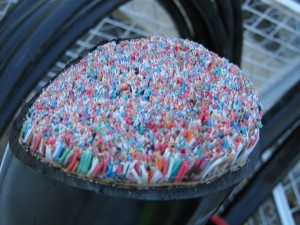Hello, and greetings from the Central Office! It’s right around winter solstice here in the Pacific Northwest, where the sun comes up around 8 in the morning and sets just after 4pm. And outside, it’s rainy, windy, and miserable. Yes, just another day of relentless winter assault on the outside plant serving my Central Office.
Around here, most people go to work in the dark and come home in the dark in often dangerous driving conditions. Inevitably, a few cars get wrapped around utility poles this time of year, knocking out electric power and telephone service. Making matters worse, they don’t call Washington the “evergreen state” for nothing. There are literally millions of Douglas fir, Sitka spruce, and Western Red Cedar trees (among others) standing over 200 feet high. Their branches are as large as entire trees in most other parts of the world. When the wind gets up to 100 miles per hour (as it did last year during the Hanukah Eve storm), falling branches can take out utility lines just as easily as falling trees. When phone lines aren’t being knocked down one way or another, they’re being pelted by rain, whipped by wind, and even stolen by thieves motivated by the high price of copper. Add to the fact that telephone cables can be decades old, and it’s sometimes a wonder that anything ever works at all.
A switch is no good if you don’t have a continuous loop to it, and most of that loop is what we call the “outside plant.” Why outside? It’s outside my Central Office. Everything in here—the switch, frame, battery room, etc. (where it’s loud, dry and a balmy 68 degrees) is the “inside plant.” And outside it is… literally millions of miles of cable criss-crossing the globe and linking nearly every household in North America. Long distance trunks are redundant, and networks are designed in ring topologies such that a cable carrying your telephone call can literally be cut in two without any impact to your conversation. Many interoffice trunks are similarly designed. Unfortunately, the most vulnerable part of the network is the loop between the Central Office and your house.
Telephone cables typically either run on poles or underground. Inside of a cable, there are up to 4,200 twisted copper pairs. A pair of thin copper wires, known as tip and ring, is what brings a dialtone to your house. This forms a continuous (albeit often spliced) copper loop between the NID on the side of your house and the frame inside the Central Office. Inside a cable, up to 100 pairs are grouped together in a collection called a “bundle,” which is wrapped in an inner sheathing, and then the bundles are wrapped together in a tough outer sheathing. There are many different types of sheathing, and the type used largely depends upon the area in which a cable is deployed and the age of the cable. For example, in Brazil (where termites are a huge problem), specialized termite-resistant outer sheathing is often used.
Hungry termites, of course, aren’t the only enemy of a telephone cable, or even the most common one. Here in the Pacific Northwest, the weather is the biggest issue for linemen to contend with. Whether a line is downed by a fallen tree or crashed automobile, police and fire departments are often the first ones to respond. Safety is a major concern of first responders, as they don’t always know whether a downed line is a dangerous high-voltage electrical line or a relatively benign telephone line. Fortunately, there is a service called One-Call, formally known as the Utility Notification Center. By dialing the appropriate telephone number, first responders report downed lines to One-Call as soon as they arrive on the scene. Based on the address and/or other identifying data (such as number plates on the affected telephone pole), One-Call then notifies the affected utilities of the outage, who each respond by rolling a truck.
Anywhere from a few minutes to several hours later (depending upon how nasty the weather is and whether the technician called is union or not—somehow, non-union techs don’t seem to like getting up at 3am in nasty weather for the measly $11 per hour their companies pay them), a truck will roll up to the scene. If multiple lines are down, multiple trucks from multiple utilities will roll. Unfortunately, if a power line is down, nobody can start repair work until the power utility shows up to de-energize the line.
Cable damage resulting from weather isn’t always as dramatic as drunks crashing into telephone poles or tree limbs crashing onto lines. Oftentimes, it happens slowly over many years. Copper does corrode when exposed to moisture, and sheathing on its own is insufficient protection against the elements. In particular, this is the case when cables are older than my mother (as is the case in parts of New York City), and are wrapped with little more than treated paper. As anyone who has ever visited Manhattan knows, there are underground steam lines everywhere—and they leak. This blasts hot, moist steam at anything in the vicinity, including telephone cables. Verizon solves the problem there by pressurizing underground cables with cold nitrogen, delivered from tanks placed throughout the city. This keeps cables dry and mitigates the corrosive impact of steam, as nitrogen is an inert gas. Similar tanks are used by AT&T in the Houston area, due to the moist climate there. You can see them placed at many junction and other equipment boxes. Conversely, in desert areas, such as the Valley of the Sun in Arizona, no measures beyond heavy-duty sheathing are taken to protect cables. This is because what little rain falls in the area evaporates quickly, and rarely penetrates far enough (or hangs around long enough) to result in corrosion damage.
Here in the Pacific Northwest, nitrogen tanks are rarely used. Most of our outside plant dates from the 1960s or later, although in a handful of places there is still cable in use dating from the turn of the 20th century. In this area, most cables are filled with a substance called icky-pic. How did it get its name? Well, icky-pic is the vilest substance known to mankind. If you get it on your clothes, in your hair, etc. you’ll never get it out. It sticks to everything, ruining whatever it touches. Including your eyes; if you get it in your eyes, it will literally blind you. Oh, and to top it off, the stuff is actually flammable (being petroleum based), so it should never be used indoors. But icky-pic is inert, and water can’t penetrate it, and it’s flexible (because it’s a gel) so you can fill cables with it. So for this area, it’s a perfect solution. That is, until the outer sheathing of the cable eventually ruptures after 40 years of neglect and the icky-pic leaks out. Eventually the cable will then corrode, and a splicer will have to repair the damage.
Splicers, incidentally, repair all sorts of interesting damage, on both fiber-optic and copper cables. From euphemistically named “backhoe incidents” (yes, any idiot with a backhoe can knock out phone service to over 1,000 homes) to underwater lines caught by boat anchors to more garden-variety damage such as drug addicts cutting out sections of cable to sell as scrap (yes, this really happens), these folks have a very tough job. Piecing 4,200 individual pairs back together is a very detail-oriented job, but good splicers need to work fast. After all, if a splicer is on the job, it usually means a lot of folks are without phone service.
Working as a lineman can be a dangerous job, since it involves working around electrical cables and more than occasionally working around slipshod, improperly grounded cabling done by low-bidding non-union contractors. For example, bucket trucks come in grounded and non-grounded versions, so as you might imagine, it’s highly important for linemen to know which tool is appropriate for the job. While linemen are not electricians (different union), they are trained in the portions of the National Electrical Code (NEC) applicable to their jobs. Safety meetings, while both frequently required and the bane of any lineman’s existence, are an important tool used to communicate the latest procedures and information.
And with that, it’s time for me to take a nap here at the Central Office. Safety meetings are the bane of my existence too, and I have a required one today. But it’s online, so I can sleep through it without anyone noticing!
REFERENCES
http://www.callbeforeyoudig.org/ – One-Call Utility Notification Center for the Pacific Northwest.
http://www.arkema-inc.com/index.cfm?pag=633 – Description of termite-resistant cable sheathing.
http://gothamist.com/2008/01/31/nitrogen_tanks.php – Article on nitrogen tanks in New York City. In particular, see the comments from SplicingDan.
http://www.psihq.com/iread/strpgrnd.htm – Proper grounding is very important in outside plant. This is a great walkthrough of the NEC (National Electrical Code) requirements for grounding.
http://sundance-communications.com/forum/ – Great message board thread on proper grounding of punch-down blocks, which is particularly interesting because of the interplay of issues that can occur during backhoe incidents. Incidentally, this particular message board is very informative on the subject of outside plant.

